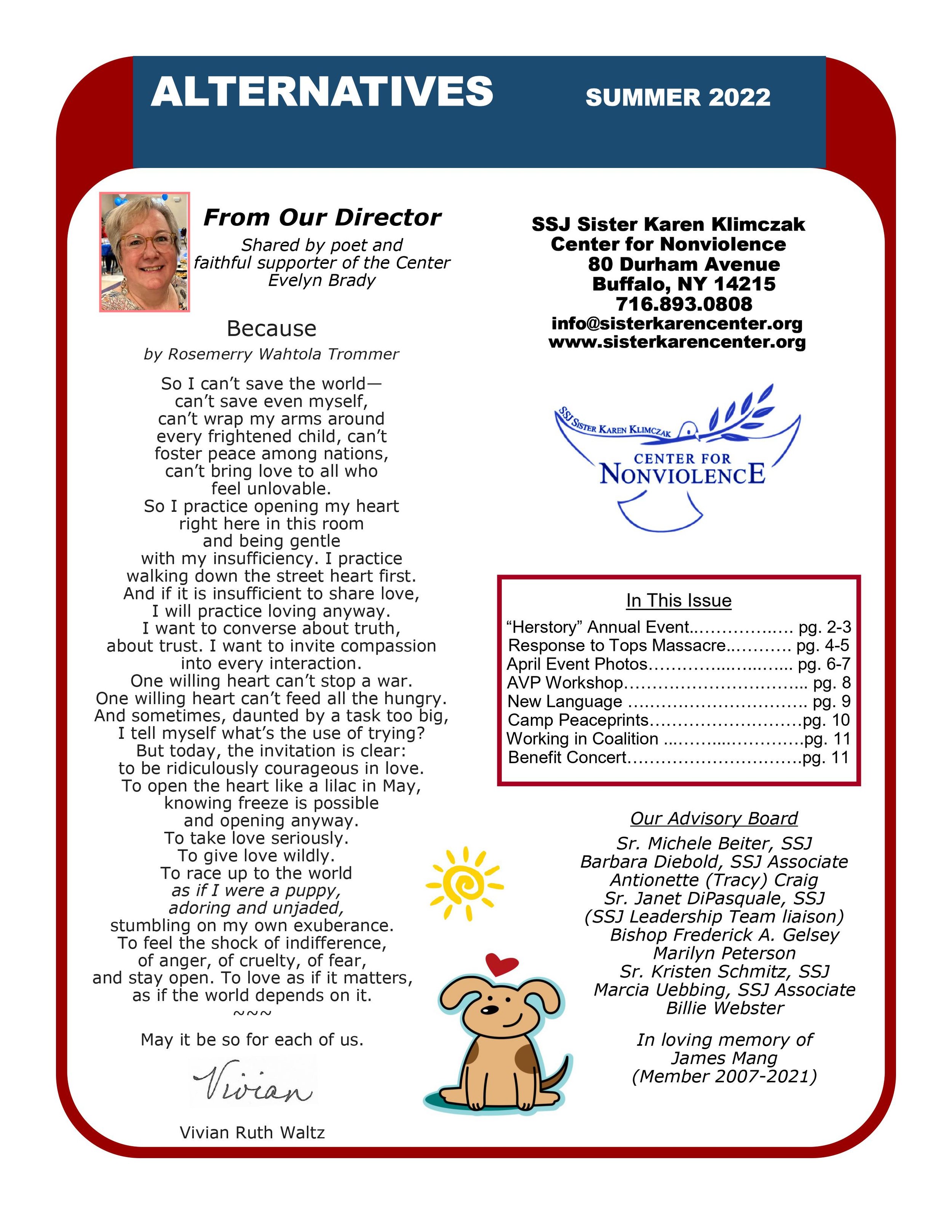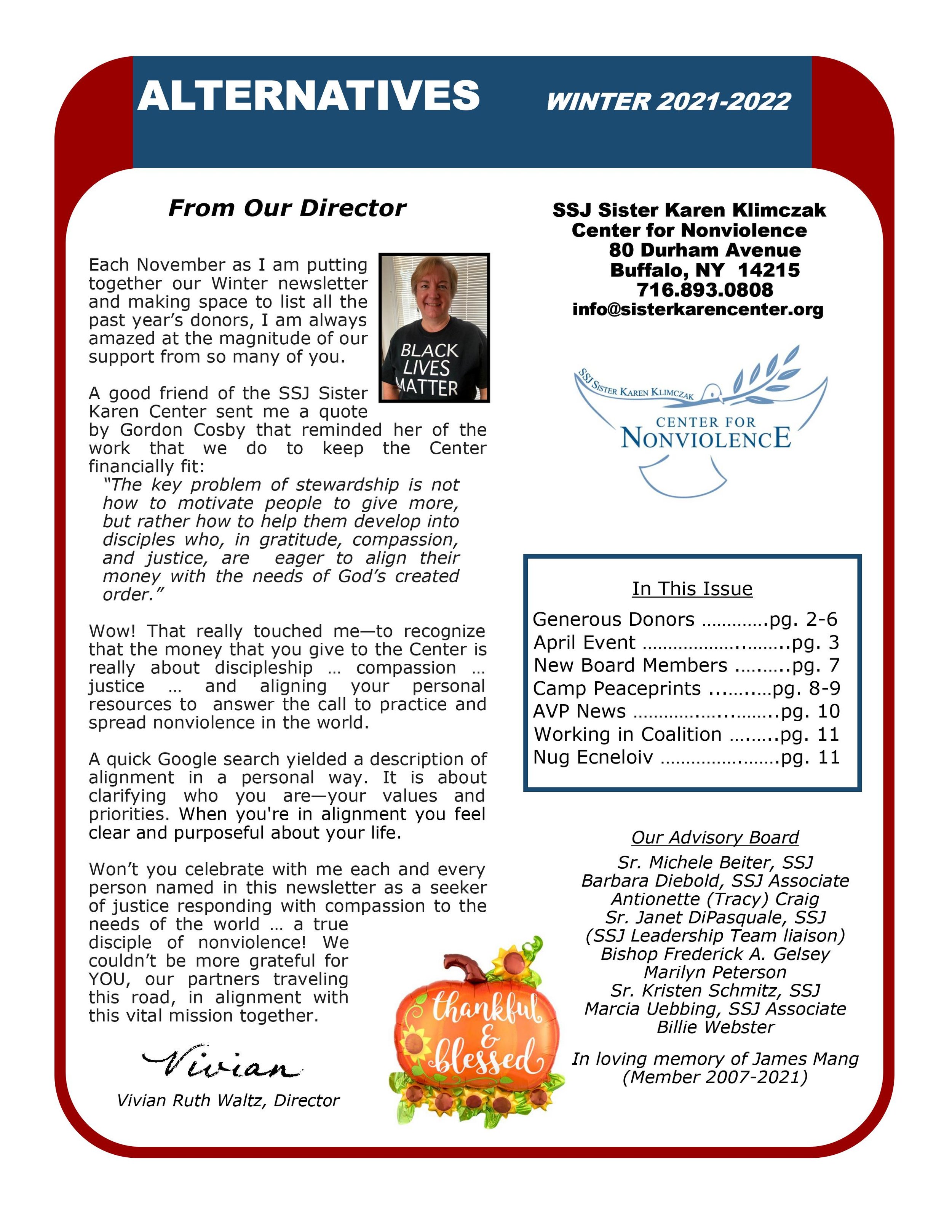“Herstory: The Cost of Nonviolence”
SSJ Sister Karen Klimczak Center for Nonviolence Annual Event
April 24, 2022
The unseasonably hot temperature outside during our annual event was matched by the fiery dancing and rapping of YO! New York youth with the blazing stained-glass window as a backdrop in the sanctuary at SS. Columba-Brigid Church. After an opening prayer by Father Roy Herberger, the teenagers took the floor in a lively routine that started “Herstory: The Cost of Nonviolence” with a burst of enthusiasm and energy!
Sister Karen Center Director Vivian Ruth Waltz then spoke to those gathered about the activities of the Center since our opening in 2007, commemorating 15 years of fulfilling our mission to eliminate violence in ourselves, in our society, and in our world. Referencing a Quinceañera, a Latina girl’s 15th birthday celebration, Vivian mused that perhaps this anniversary is a time to mark the Sister Karen Center’s development from infancy to maturity.
Although interrupted by the pandemic, our Alternatives to Violence Project program in the community has been successful with such diverse groups as homeless youth, Catholic seminarians, trauma therapists and gang interventionists. The AVP program at Wende Correctional Facility is well-established, awaiting the return of volunteers to the prison. This July will mark our 15th year of Camp Peaceprints, our alternative day camp designed to introduce youth to social justice, while providing them with peaceful conflict resolution skills and exposure to a broader community.
Following the celebration of the work of the Sister Karen Center, Audrey Mang (who, along with her husband Jim, was an interim director of the Center when we opened) came forward to present the “Nonviolence Begins with Me” Award to Margaret Honora McAloon, M.D. A close friend of Sister Karen in her work and ministry, Maggie felt called to continue Sister Karen’s mission when she was so tragically taken from us. Maggie gave a large inaugural gift that helped establish the SSJ Sister Karen Klimczak Center for Nonviolence in 2007 on sound financial footing. Tears were flowing as she accepted the award with gratitude and expressed how proud she is to be associated with the Center.
It was time for Sister Karen Center board member Tracy Craig to introduce our featured speaker Cariol Horne. Tracy recounted that Cariol’s motivation for becoming a police officer was to influence children to become good citizens. She welcomed Cariol to the podium by affirming that it is a privilege for the Sister Karen Center to be part of sharing Cariol’s story today.
To begin her talk, Cariol told us that as a young person she attended church daily and that her parents strived to “instill Christ within us” to be forgiving, loving, and caring. She said that in her life she has sacrificed a lot for other people and especially for her children.
After asking for a show of hands of those who are aware of police brutality in our country and in our community, Cariol stressed that we have to acknowledge that it is happening. As a Buffalo police officer in 2006, Cariol acted to protect an a handcuffed arrestee from a fellow police officer who had him in a chokehold. Cariol grabbed the officer’s arm that was around his neck. “I did what people want officers to do – to intervene when they are being abusive.”
Cariol’s intervention resulted in termination from the Buffalo Police Department and a loss of benefits just months before she was eligible for retirement. She asked us rhetorically, “Who am I going to go to? Who am I going to tell? Some of the officers who were abusive were supervisors.” Cariol believes she had PTSD long before she was fired from watching what was going on and not being able to do anything about it. “Just because someone has been arrested, it doesn’t mean they deserve to be abused,” she declared.
Cariol started thinking of a way she could help other officers who wanted to protect citizens from police using excessive force. In 2016 with the help of legal advisors, she drafted a Duty-to-Intervene Law which became known as Cariol’s Law. In addition to legislating the duty to intervene if an officer poses an imminent threat to a citizen, the law includes accountability for officers neglecting to intervene, protection of officers who do intervene and accountability for falsifying reports (which happened in her case). Also included is a policy regarding termination, and a mandate to use restorative justice practices for retaliation against a “whistle blower.”
Cariol told us that after the death of George Floyd in May of 2020, her story went national. She made us chuckle by saying, “At that point, I raised holy…water!” She and other activists hit the streets of Buffalo to protest George Floyd’s murder as well as her treatment by the BPD. A team of local supporters - activists, advocates, lawyers, teachers, and artists from all different walks of life -pressed the City of Buffalo to pass Cariol’s Law. The law was passed by the Buffalo Common Council in September 2020.
Working with a social justice organization in Chicago which partnered with Harvard Law School, Cariol filed a lawsuit and her termination was overturned. Her pension was reinstated, though she shared that she hasn’t seen one penny of it yet. In rendering his opinion, the presiding judge quoted Martin Luther King, Jr., “The time is always ripe to do what is right.”
Cariol then talked about her call to influence children and youth. She shared about her son and how his interest in music helped to keep him and his friends out of trouble. Although she did her best to teach them about peer pressure and to stand firm if someone was trying to pull them in a dangerous direction, Cariol’s son tragically ended up as a witness to a murder. At the time of our event he was in the East Ferry Youth Detention Center. The SNUG anti-violence program he had participated in was paused during the pandemic and Cariol said that without this program he was vulnerable. Cariol hopes to resume her pre-pandemic work with youth soon. She feels this is her mission in life. She urged us, “We have to come together to help our kids because they are our future.”
There was a Question and Answer time next where Cariol asked those in the audience to advocate for her Duty-to-Intervene Law to become a federal statute. Then, as is our custom at the end of every annual event, we joined in singing, “Peaceprints.” This year we were thrilled to have the composer, David Granville, on the piano to joyfully lead us. We committed once again to follow Sister Karen’s call to Leave Peaceprints in our community and in our world.
Delicious mini-sandwiches prepared by the Sisters of St. Joseph food service were enjoyed at the reception following the program, along with lively conversation and much laughter. We are grateful to all our sponsors and to everyone who joined us for this special day to make our annual event a success!
**SEE PHOTOS ON ANNUAL EVENT PHOTO PAGE**
“Herstory: The Cost of Nonviolence”
SSJ Sister Karen Klimczak Center for Nonviolence Annual Event
The SSJ Sister Karen Klimczak Center for Nonviolence is excited to announce our annual fundraising event which will once again be live and in person at SS. Columba-Brigid Church, 75 Hickory Street in Buffalo on Sunday, April 24th at 3 pm. A reception will follow.
This year our speaker will be Cariol Horne and the event is titled “Herstory: The Cost of Nonviolence.” Cariol is a former Buffalo police officer who was the inspiration for the Duty-to-Intervene law passed by the City of Buffalo in 2020. Known as “Cariol’s Law” it requires officers to step in if another officer is thought to be using excessive force on a suspect.
In her presentation, Cariol will tell her story of the incident where she acted to protect an arrestee from a fellow police officer Her intervention resulted in termination from the Buffalo Police Department and a loss of benefits just months before she was eligible for retirement. She will share the long journey of seeking justice for herself and for those she has vowed to serve and protect.
Like Sister Karen’s life, Cariol’s personal story is a testament to the power of one person to create a more just and peaceful community. We hope you will join us for what promises to be a compelling and captivating presentation!
Tickets are $25 each and are available by calling 716.893.0808, on the website at www.sisterkarencenter.org or at the door.
Vivian Ruth Waltz, Director













